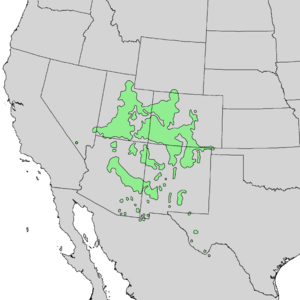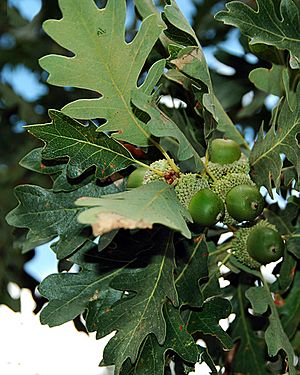Gambel oak facts for kids
Quick facts for kids Gambel oak |
|
|---|---|
 |
|
| Conservation status | |
| Scientific classification | |
| Genus: |
Quercus
|
| Species: |
gambelii
|
 |
|
| Natural range of Quercus gambelii | |
| Synonyms | |
|
List
Quercus gambeli Nutt.
Quercus albifolia C.H.Mull. Quercus confusa Wooton & Standl. Quercus eastwoodiae Rydb. Quercus gunnisonii Rydb. Quercus leptophylla Rydb. Quercus marshii C.H.Mull. Quercus media Wooton & Standl. Quercus nitescens Rydb. Quercus novomexicana (A.DC.) Rydb. Quercus obtusifolia (A. DC.) Rydb. Quercus submollis Rydb. Quercus subobtusifolia A.Camus Quercus utahensis (A.DC.) Rydb. Quercus vreelandii Rydb. |
|
The Gambel oak (scientific name: Quercus gambelii) is a type of small tree or large shrub that loses its leaves every year (it's deciduous). You can find it all over the lower mountains and foothills in western North America. People sometimes call it scrub oak, oak brush, or white oak.
It got its name from an American naturalist named William Gambel, who lived from 1821 to 1849.
Contents
Where Gambel Oaks Grow
Gambel oaks mostly grow in the western United States and northwestern Mexico. You can find them in states like Arizona, Colorado, New Mexico, and Utah. They also grow in parts of Nevada, Wyoming, Idaho, and Texas.
These trees usually grow at high places, from 3,300 to 9,800 feet (1,000 to 3,000 meters) above sea level. In these areas, they get about 12 to 24 inches (30 to 60 centimeters) of rain each year.
What Gambel Oaks Look Like
Gambel oak trees can be different sizes depending on where they grow. Most mature trees are about 10 to 30 feet (3 to 9 meters) tall. But in some places, they can reach up to 60 feet (18 meters) tall! The tallest known tree is in Arizona, standing at 114 feet.
In areas where animals eat a lot of plants, you might find very short Gambel oaks, less than 3 feet (1 meter) tall. The biggest trees are often found near streams in the southern parts of their range.
The wood of the Gambel oak is strong and heavy. Its branches are often twisty, but they are flexible. This helps them bend without breaking when covered with heavy snow. The bark is rough and looks brownish-gray.
Leaves, Flowers, and Acorns
The leaves are usually 3 to 5 inches (7 to 12 cm) long and 1.5 to 2.5 inches (4 to 6 cm) wide. They have deep cuts on each side of the middle vein. The top of the leaf is shiny dark green, and the bottom is lighter and feels soft. In autumn, the leaves often turn bright orange and yellow, making the mountainsides look very colorful.
The flowers are small and not very noticeable. They grow in long clusters called catkins in the spring.
The acorns are about 0.4 to 0.8 inches (10 to 20 mm) long. About one-third to one-half of the acorn is covered by a cap. They become ripe in September, changing from green to golden brown.
How Gambel Oaks Reproduce
Gambel oaks grow from acorns. But they also spread quickly from sprouts that grow from large underground structures called lignotubers. Because of this, you often see dense groups or thickets of these trees covering entire mountainsides.
Where Gambel Oaks Live
Gambel oaks grow best in sunny spots on hillsides. They prefer thin, rocky soil that is a bit alkaline (not acidic). This kind of soil limits other plants from growing too close. They also do well in richer soils, but there they have more competition.
These trees are good at living in places with wet springs and hot, dry summers. These conditions often lead to wildfires. After a fire, the Gambel oak quickly grows back from its root sprouts. The plant can also handle dry weather very well.
Other plants that often grow near Gambel oaks include chokecherry, bigtooth maple, and ponderosa pine. Many animals also live in Gambel oak habitats, such as deer, chipmunks, squirrels, and wild turkeys.
Uses of Gambel Oak
Because there are so many Gambel oaks, they are an important food source for animals like deer and livestock. Squirrels often collect the sweet acorns and store them for winter. Wild turkeys, black bears, and even farm animals like hogs also eat the acorns.
Some insects rely on the Gambel oak too. For example, the caterpillars of the Colorado hairstreak butterfly eat its leaves. Long ago, acorns from Gambel oaks were a dependable food source for Native Americans. People today can also eat them, but if they taste bitter, they might need to be soaked in water to remove bitter substances called tannins.
See also
 In Spanish: Quercus gambelii para niños
In Spanish: Quercus gambelii para niños




